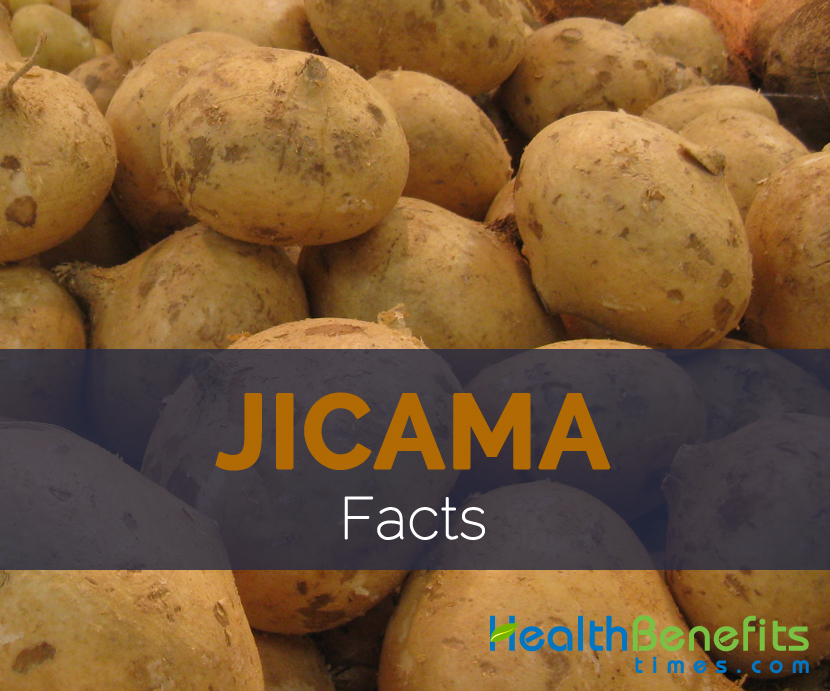 Jicama also known as Yam bean (pronounced he’-cama) is a Vitamin C rich vegetable native to Central America – from South Mexico to Hicaragm and Costa Rica. It is yellowish-brown colored large turnip-like shaped tuberous roots having creamy succulent white, crisp starchy flesh. IT has been used in several recipe through out the world.
Jicama also known as Yam bean (pronounced he’-cama) is a Vitamin C rich vegetable native to Central America – from South Mexico to Hicaragm and Costa Rica. It is yellowish-brown colored large turnip-like shaped tuberous roots having creamy succulent white, crisp starchy flesh. IT has been used in several recipe through out the world.
| Name | Jicama |
|---|---|
| Scientific Name | Pachyrhizus erosus |
| Native | Native to Central America – from South Mexico to Hicaragm and Costa Rica -and has naturalized elsewhere after introduction. |
| Common/English Name | Mexican Potato, Ream, saa got, ChopSuey B.n, ahipa, Yam Bean. Indian Potato; Chop Suey Bean, Mexican licama, Three-Lobed- Leaver, Mexican Yarn Bean, Chinese potato, Manioc B.n,! Yam Bean, Foumrsoked-Root Yam Bea,Short-Podded Yam Bean |
| Name in Other Languages | Argentina: Paso, atat Vietnamese: C. eh Diu (Northern Vethigh) Khmer: PeThek hrksh: Kfik10 Bityrgice Mexio: licarna Thai: Man Kam Huspackua, Man Lao aya: MeheoChikam Chinese: Bai Gua, Dou Shu, Fan Ge, Fan Ko French: °phone Bullamme, Dohs,. 11Mereux India: Shankalu (Bengali), Kasaur (Ohm) Kaliegn: ragiolo Pato, Dolico Bulbows Brasil: Wag Danish: Mexikansk l’amstotnne Venezuela: Caro. De Cabello Now, Opera Peru: ‘Kama. liguime Laotian: Man Ph’ats Malaysia: Mmgkion, Mengkuan, Sengkuang German: tramhohne, Yarnabohne, Knollige Japanese: Buzuimo Nepalese: Ks Burmese:Pre Blyi, ane-Saar Dutch: Bengkoewang, Hoewi ins, Hoewi Hirim Melanesia: Beingkawang, Besusu (Javanese) |
| Description | Jicama is a subglobose, large turnip-like shaped tuberous vegetable consumed due to its numerous health promoting benefits. Although seeds, leaves, flowers, pods are toxin, jicama root is full of essential nutrients, mineral, vitamins and lipids. |
| Plant Growth Habit | Vigorous, subtropical and tropical, climbing legume vine |
| Growing Climate | Semitropical and tropical climates |
| Soil | Prefers a rich, sandy, moist, loam soil along with good drainage which is high in potassium |
| Plant Size | 4–5 m long |
| Leaf | Leaves are pinnately trifoliate, coarse, stipules lan¬ceolate or falcate, 0.5-1 cm long, petiole 10-15 cm long. |
| Leaflets | Leaflets are shortly stalked obliquely ovate or rhomboid, base cuneate, apex acute, green 6.5-13cm long by 5-15 cm wide |
| Flower | Shortly pedicelled pretty, big, blue pea flowers |
| Pods | Pods are subsessile, linear, acuminate, compressed, finely pubescent 5-10 seeded 7.5-15cm long and 1.2-1.6 cm wide |
| Root shape & size | subglobose, large turnip-like shaped tuberous roots 10-20 cm or more across |
| Root Weight | 3 kg or more |
| Root color | Yellowish-brown, coarse, membranous |
| Root Flesh Color | Creamy succulent white, crisp starchy flesh that resembles raw potato or pear. |
| Root Peel | Thick dust-brown color inedible skin |
| Flavor/aroma | Slightly sweet, little nutty, starchy, crispy and pleasant, reminiscent of apples or raw green beans |
| Root Taste | Best described as a cross between a water chestnut and an apple. |
| Seed | Seeds flat rounded to squarish, olive-green to brown or reddish brown |
| Varieties/Types | jicama de agua, Pachyrhizus tuberosus (Amazonian yam bean, jíquima), jicama de leche, Pachyuhizus ahipa (Andean yam bean) and Pachyrhizus erosus (Mexican yam bean) |
| Major Nutrition | Vitamin C 14.1 mg (15.67%) Total dietary Fiber 4.9 g (12.89%) Iron 0.57 mg (7.13%) Carbohydrate 8.82 g (6.78%) Copper 0.046 mg (5.11%) Vitamin B6 0.04 mg (3.08%) Vitamin E 0.46 mg (3.07%) Potassium 135 mg (2.87%) Magnesium 11 mg (2.62%) Manganese 0.057 mg (2.48%) |
| Health Benefits |
|
| Calories in 1cup (100gm) | 38 |
| Precautions: |
|
| How to Eat |
|
Jicama (Pachyrhizus erosus) Scientific Classification
| Scientific name | Pachyrhizus erosus |
|---|---|
| Kingdom | Plantae |
| Subkingdom | Tracheobionta |
| Order | Fabales |
| Family | Fabaceae ⁄ Leguminosae |
| Genus | Pachyrhizus Rich. ex DC |
| Species | Pachyrhizus erosus (L.) Urb. |
| Super division | Spermatophyta |
| Division | Magnoliophyta |
| Class | Magnoliopsida |
| Sub Class | Rosidae |

